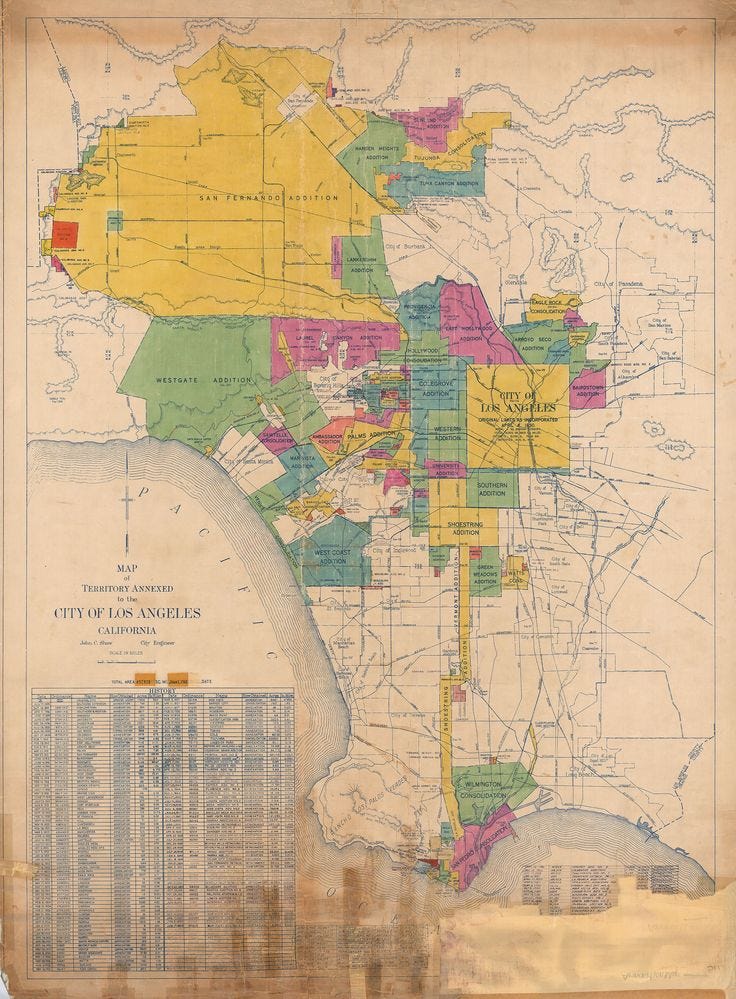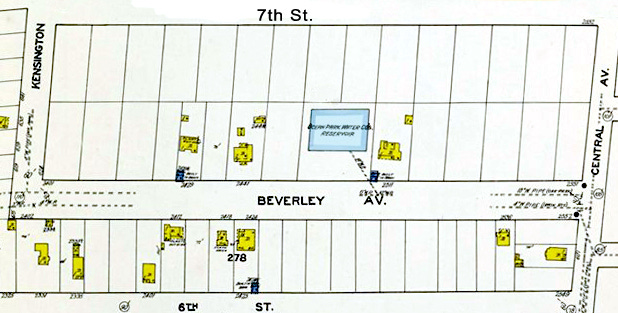This is the 3rd in a series about Ocean Park’s water supply. In 1916, Santa Monica attempts to solve its water crisis by forming its own municipal water department.
By the early 1900s, the Santa Monica water supply (particularly for firefighting) is not equal to the growing city. In 1905, the City Council schedules a water bond election for a municipal water system. But voter opinion quickly swings - the city is moving too fast and is already heavily bonded - the election is re-called.1
By 1911, protests surrounding the water shortages mount. Santa Monica (pop. 12,000) is growing rapidly and the owners of the water systems cannot obtain funds to upgrade their systems. The City orders the arrest of C.H. Mellen (1862 - 1946),2 manager of the Ocean Park Water Company, for failing to supply adequate water. In 1912, the City files a similar suit against the Santa Monica Water Company. Against this background, offering access to Owens River water,3 the City of Los Angeles seeks to annex Santa Monica.4
Santa Monica attempts to solve its water crisis by forming its own municipal water department by the forced sale (price is set by California Railroad Commission) through eminent domain of the four private water companies serving Santa Monica:
Santa Monica Water Company - $402,500
Irwin Heights Water Company - $75,000
Ocean Park Water Company - $77,500
City Water Company - $107,500
The total is $662,500, and with an additional allowance of $50,000 for future improvements, Santa Monica prepares a $712,500 bond issue.5 In 1915, Santa Monica holds an election to approve the bonds - but the bond election narrowly fails.6 The issue is revived7 and passes in 1916.8
“It’s the best thing that ever happened to Santa Monica” - T.H. Dudley (Santa Monica Bay Outlook, May 27, 1916)
By purchasing all four private water companies, Santa Monica now has total control over its water supply.9 Water meters are installed throughout the city - previously, there is just a connection fee billed monthly. Santa Monica abandons the City Water Company and Ocean Park Water Company wells,10 and water for Ocean Park is piped from Irwin Heights.11
On December 27, 1905, the water bond election is set for January 16, 1906. The bond is for $250,000 to “acquire a municipal water system” - but there is no actual plan for how the money will be used. Public opinion swings against the proposal, and on January 6, 1906, the City Council pulls the plug on the bond election.
C.H. Mellen (1862 - 1946). Born in PA, comes to Pomona 1892. In 1911, marries Mrs. Laura Belle Hipple McDowell (1868 – 1964). Director First National Bank of Ocean Park. Manager of Ocean Park Water Company. Lives at 2527 3rd St.
In 1905 City of Los Angeles voters approve a $23 MM bond issue to buy land and water rights in the Owens Valley. The 233-mile aqueduct from the Owens Valley to Los Angeles is completed in 1913.
The City of Los Angeles charter does not allow it to sell its surplus water and seeks to share the cost of the Owens Valley project by annexing surrounding cities. State law only allows the annexation of contiguous cities. Santa Monica has one-fortieth the population of Los Angeles.
The 5% bonds are to be paid off over 40 years (1916 - 1956). R.H. Mouton & Company, a California municipal bond specialist, buys the $712,500 bond issue for a premium of $52,000.
In the December 1915 Santa Monica water bond election 1,954 of the 2,978 votes favor the bond - this falls 31 votes short of the required 2/3rds majority.
Following the unsuccessful December 1915 Santa Monica water bond election, two issues gain voters' attention. Firstly, the private water companies apply to the California Railroad Commission for substantial rate increases. Secondly, the City of Los Angeles schedules a June 1916 charter election - part of which (Proposition #8) would allow Los Angeles to sell Owens Valley water to Santa Monica (without annexation). Santa Monica wants to have a municipal system in place to negotiate with Los Angeles for the water. This second concern is moot when Los Angeles votes down Proposition #8.
In the revived May 1916 Santa Monica water bond election 2,489 of the 3,591 votes favor the bond - 95 votes beyond the required 2/3rds majority.
The Ocean Park Water Company sells its Venice (7th & Rose) plant to the City Water Company, and goes out of business. The City Water Company continues to operate in Venice.
The Santa Monica plant of the four water companies comes under the control of the Public Works Department.
In 1915, Santa Monica city government is structured as a three-person full-time board of commissioners, set up to meet daily and set policy. William H. Carter (1879 - 1936) is the Commissioner of Public Works.
By 1915, the City Water Company Plant #2 (7th & Ozone) has not been used in 2 years and essentially has been abandoned. Plant #3 (Marine & Longfellow) is rarely used and is kept in reserve.
The Ocean Park Water Company (Highland & Ozone) and City Water Company wells are close together drawing down the same aquifer. There is concern about over-pumping the aquifer with possible saltwater intrusion. Irwin Heights water comes from different strata and is of better quality.
In 1916, a new 12-inch steel pipe main brings (by gravity flow) water from the Irwin Heights (18th & Pearl) reservoir to Ocean Park (Beverley) reservoir. In 1917, it is decided to abandon the existing Irwin Heights and Beverley reservoirs. A new 1.50 million gallon reservoir (130 ft in diameter by 15 ft deep) is built at Irwin Heights to supply all of Santa Monica south of Colorado. The Beverley reservoir is not used but kept in reserve. In 1920, G. Merritt Jones of City Water Company seeks to rent / buy the Beverley reservoir but decides against it. In 1960, the Tiki apartments replace the Beverley reservoir.







